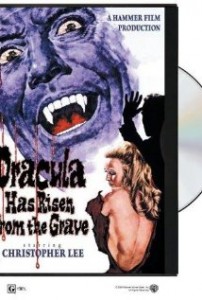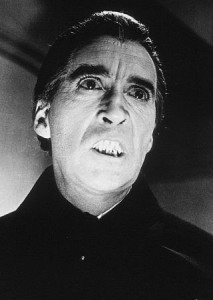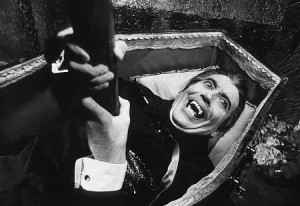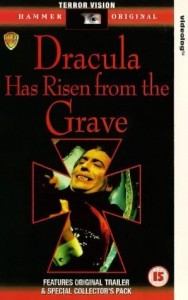Dracula Has Risen from the Grave *** (1968, Christopher Lee, Rupert Davies, Veronica Carlson) – Classic Movie Review 1733
Director Freddie Francis’s 1968 horror movie sequel Dracula Has Risen from the Grave is the quite stylish and still welcome third episode in the Christopher Lee Hammer Films series, following Terence Fisher’s Dracula in 1958 and Dracula: Prince of Darkness in 1965, in which Dracula was destroyed yet again.
The inestimable Lee re-creates his most famous role as the Count who revives and emerges in vengeful mood from his Transylvania castle to pursue Maria (Veronica Carlson), the sexy young niece of Monsignor Ernest Mueller (Rupert Davies).
In 1906, after the events in Dracula: Prince of Darkness, the Monsignor comes to the East European village of Keinenberg, where he finds an altar boy (Norman Bacon) has become a frightened mute and the local priest (Ewan Hooper) has lost his faith a year after they found a Dracula victim inside the church bell.
Monsignor returns to Dracula’s nearby castle in the mountains with the priest to exorcise his castle, but the priest gives up and will go no further, so Monsignor tells him to wait there in the mountains for his return. As Monsignor goes on alone and exorcises the castle, placing a metal cross on its gate, there is a thunderstorm. The priest flees, but falls and hits his head on a rock, his blood trickling into a frozen stream through a crack in the ice, and onto the lips of Count Dracula, reviving him. Dracula captures the priest, who leads Dracula to Keinenberg, where he plots to take his revenge on Monsignor’s beautiful niece Maria by attempting to make her his bride.
It is effective. lurid Sixties-style horror fare, quite gruesome for its day (the UK censor cut close-ups of Dracula pulling a stake from his heart), directed with some considerable imagination, gusto and even a little subtlety by Francis, and written in style and conviction by Anthony Hinds. Its main virtue, though, must be that it is led by the splendidly menacing Lee’s gracefully chilling performance, even with a few lines to say this time after his previous wordless appearance. He is a commanding presence and a great attraction.
Its problem, though, is all the extended, drossy, boring stuff in Keinenberg when Monsignor returns home on the day of the birthday of his niece Maria, who lives in his house with her widowed mother Anna (Marion Mathie). Maria is in love with the atheist Paul (Barry Andrews), who works with the sexy, flirtatious waitress Zena (Barbara Ewing) in the bar owned by his friend Max (Michael Ripper), the landlord of the pub where he also lives. And the film’s religious element, with the priest losing his faith, the villagers refusing to attend mass and the non-believer Paul coming into conflict with the Monsignor, is a weighty burden to the film too. The writing here is weak and muddled, often seeming to lose sight of Dracula or the plot, and some of the acting is none too special here either, though Ewing and Ripper both have a good time in lusty performances.
There is support from Barry Andrews, Barbara Ewing, Ewan Hooper, Marion Mathie, George A Cooper, Michael Ripper, John D Collins, Christopher Cunningham, and Norman Bacon.
The 1958 Dracula and Dracula: Prince of Darkness were both made at Bray Studios but this one was shot at at Pinewood Studios, Iver Heath, Buckinghamshire, England, so the approach road, coach path and moat seen in front of Castle Dracula are missing this time. There is some location work as Zena is chased (unconvincingly) by Dracula’s coach at nearby Black Park Lake, Iver Heath, Buckinghamshire, England.
Terence Fisher was to direct the film again, but was ill so Freddie Francis took over. He got cinematographer Arthur Grant to use his coloured filters so that the frame edges are tinged crimson, amber and yellow when Dracula or his castle is seen, so the Technicolor film has an interesting, lurid look about it.
It turned out to be Hammer Films’ most profitable movie.
Next sequel: Taste the Blood of Dracula (1970).
Veronica Carlson is one of Hammer Films’ most memorable stars. The British model and actress was signed by Sir James Carreras after he saw one of her photographs in a newspaper, and she made three films for Hammer: Dracula Has Risen from the Grave, Frankenstein Must Be Destroyed (1969) and The Horror of Frankenstein (1970). She also appeared in Vampira [aka Old Dracula] (1974), The Ghoul (1975) and House of the Gorgon.
Veronica Carlson, born in Yorkshire, England, as Veronica Mary Glazer, died on 27 February 2022, aged 77.
© Derek Winnert 2014 Classic Movie Review 1733
Check out more reviews on http://derekwinnert.com/








